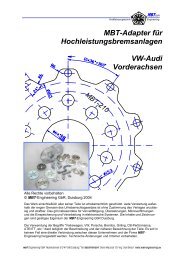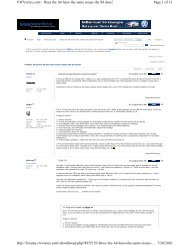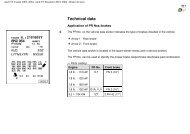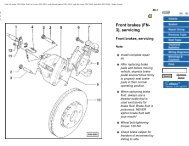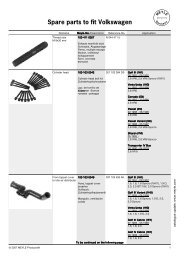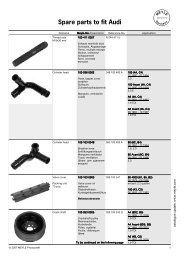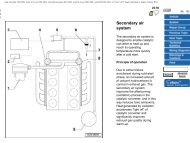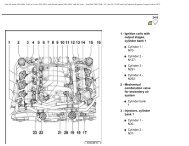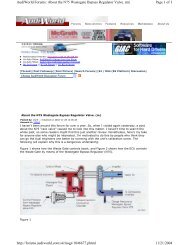VW MKII A2 MK2 Golf Jetta Fox Service Manual - VAGLinks.com
VW MKII A2 MK2 Golf Jetta Fox Service Manual - VAGLinks.com
VW MKII A2 MK2 Golf Jetta Fox Service Manual - VAGLinks.com
You also want an ePaper? Increase the reach of your titles
YUMPU automatically turns print PDFs into web optimized ePapers that Google loves.
3.4 CO analyser and connecting pipe 3.7 Idle speed (A) and mixture adjustment<br />
(B) screws<br />
3 Idle speed and mixture -<br />
adjustment 4<br />
1 The idle speed can only be accurately<br />
checked using a suitable tachometer and an<br />
exhaust CO analyser. <strong>VW</strong> re<strong>com</strong>mend that the<br />
inlet air temperature sender in the airflow<br />
meter must ideally be set to 1.8 K ohms to<br />
provide a neutral air inlet temperature. As this<br />
requires the use of specialised <strong>VW</strong><br />
equipment, an approximate check/setting will<br />
therefore have to suffice.<br />
2 When checking or making any adjustments<br />
to the idle speed, it is important to adhere to<br />
the following:<br />
a) The engine must be at its normal<br />
operating temperature<br />
b) All electrical <strong>com</strong>ponents must be<br />
switched off, including the cooling fan<br />
4.1a Control unit plug showing terminal<br />
connectors<br />
4.1b Intake air temperature sender<br />
resistance graph<br />
c) The ignition timing adjustment must be<br />
correct<br />
3 Pull free the crankcase ventilation hose<br />
from the pressure regulating valve and plug it.<br />
4 With the ignition switched off, connect a<br />
tachometer in accordance with the<br />
manufacturer’s instructions, then connect the<br />
CO analyser to the measuring pipe (see<br />
illustration). An adapter will probably be<br />
needed to ensure a good seal between the<br />
analyser hose and measuring pipe.<br />
5 Disconnect the Lambda probe wiring plug<br />
from its in-line connector.<br />
6 Start the engine and check that the idle<br />
speed and CO content are as specified. If the<br />
idle speed is too high, check that the throttle<br />
valve is fully closing before making any<br />
adjustments to the idle speed.<br />
7 If adjustment to the idle speed and/or the<br />
mixture (CO content) is required, turn the<br />
appropriate adjuster screw as necessary (see<br />
illustration).<br />
8 If the CO content is to be adjusted, the<br />
mixture screw’s tamperproof cap will have to<br />
be carefully prised free and a suitable Allen<br />
key used to make the adjustment. On models<br />
produced from July 1989 on, the idle speed<br />
should initially be between 900 to 1000 rpm<br />
and the CO content between 1.0 and 1.4%.<br />
When the Lambda probe is reconnected, the<br />
idle speed and the CO content should settle<br />
down to the specified setting. Fit a new<br />
tamperproof cap over the mixture screw on<br />
<strong>com</strong>pletion.<br />
9 With the idle speed/CO content correct,<br />
disconnect the analyser and reconnect the<br />
Lambda probe wiring plug.<br />
4 Airflow meter - testing<br />
Fuel and exhaust systems - Digijet fuel injection 4E•3<br />
2<br />
The efficiency of the airflow meter in the<br />
inlet manifold is checked by measuring the<br />
resistance value between contacts 1 and 4 of<br />
the control unit plug (see illustrations).<br />
The potentiometer is measured in the same<br />
manner by connecting the probes to terminals<br />
2 and 3 and simultaneously operating the<br />
airflow sensor plate. The resistance reading<br />
must be seen to fluctuate.<br />
1081 <strong>VW</strong> <strong>Golf</strong> & <strong>Jetta</strong><br />
5 Inlet air pre-heater - testing<br />
2<br />
1 The inlet air pre-heater is fitted to engines<br />
manufactured from September 1989.<br />
2 A hot air blower such as a hair dryer can be<br />
used to test the pre-heater. First release the<br />
retaining clips, lift the lid from the air cleaner<br />
unit and remove the element - see illustration,<br />
Section 32, Chapter 1.<br />
3 With the engine cold and with the air<br />
temperature around the pre-heater between 5<br />
to 15° C, the warm air flap valve must be seen<br />
to be open. On heating up the air temperature<br />
in the area of the air inlet valve to over 20°C,<br />
the valve should be seen to close.<br />
6 Fuel injectors - testing<br />
3<br />
Refer to Section 13 in Part B of this Chapter<br />
and proceed as described. Note however that<br />
the dribble test in paragraph 5 differs. Switch<br />
on the ignition for a period of 5 seconds and<br />
check that no more than 2 drips per minute<br />
leak from any of the injectors.<br />
7 Throttle valve switch - testing<br />
2<br />
1 A multi-meter (set to the resistance scale)<br />
will be required to make this test.<br />
2 Pull free the wiring connector from the<br />
throttle valve switch, connect up the meter<br />
probes between the switch contacts and<br />
check that the reading is zero ohms (see<br />
illustration). Operate the throttle to fully open<br />
it (a high ‘infinite’ resistance reading will be<br />
shown on the meter), then slowly close the<br />
throttle to the point where 0.3 mm clearance<br />
exists between the throttle lever and the stop<br />
screw. Check that zero ohms is shown on the<br />
meter.<br />
7.2 Throttle valve switch test meter<br />
connections and securing screws<br />
4E



